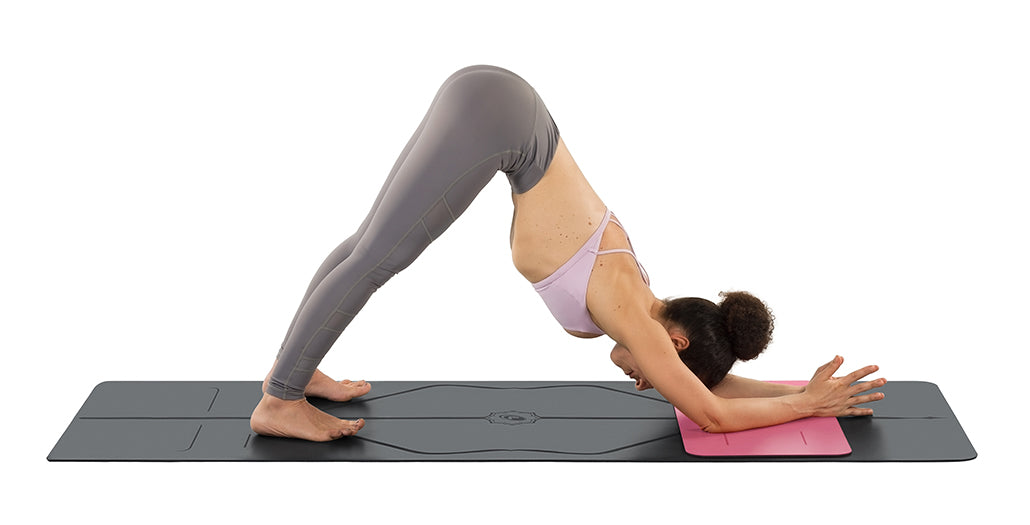Dolphin Pose is a variation of Downward Facing Dog in which you bend your elbows and bring your forearms down to the mat. Since the focus shifts from the hands to the forearms, it provides a convenient alternative to Down Dog for people who need to avoid putting pressure on their wrists.
Even if wrist pain isn’t a concern for you, practising Dolphin Pose has its own unique benefits. This pose helps build strength and flexibility in the shoulders and back, which are essential in preparation for inversions like Headstand and Forearm Stand.
Dolphin Pose Basics
-
Sanskrit Meaning: Ardha (Half) Pincha (Feathered) Mayur (Peacock) Asana (Pose)
-
Yoga Level: Intermediate
-
Pose Type: Forearm Balance, Inversion, Strengthening
Benefits of Dolphin Pose
- Stretches the hamstrings and calves
- Opens and strengthens the shoulders and upper back
- Improves arm and core strength
Instructions:
- Come to a hands and knees kneeling position at the centre of your mat.
- Slide your palms forward to lower your elbows to the mat so that you are on your knees and forearms with your shoulders stacked directly over your elbows. The forearms should be parallel and shoulder-width apart.
- Press strongly into your contact points with the mat (fingers, palms, forearms, and elbows) to engage the muscles around your shoulder girdle and lift your chest away from the floor.
- Curl your toes under and lift your hips to a Downward Facing Dog position.
- When you take your hips up and back, your shoulders will also naturally shift back.
- Keep actively pressing down through your arms to lift your chest.
- Let your head hang easy, though it should not touch the floor.
Transition to Forearm Stand
Once you feel stable in Dolphin Pose, you can start preparing your body for inversions:
- If you are working toward Forearm Stand (Pincha Mayurasana), start by walking your feet in bit by bit, eventually bringing your shoulders over your elbows and your hips closer to being over your shoulders.
- Once you have walked your feet in as close as possible, you can also practice lifting your head to bring your gaze to the floor between the palms.
- Lifting one leg at a time will start to give you the feeling of transferring your weight into your forearms.
See also: Inverted Yoga Poses Guide
Dolphin Pose Variations and Use of Props

- Instead of having the forearms parallel and palms flat, you can clasp your hands, creating a V shape with your forearms (much like the position you take for a Headstand). Tucking your bottom pinky in will make this more comfortable when you begin to put pressure on your hands.
- If it’s difficult to keep your forearms parallel because your elbows want to splay outward, a strap and/or a block can help. Adjust a strap so that it fits snugly around your upper arms just above the elbows, keeping them shoulder-width apart. You can press your arms outward into the strap for additional stability.
- Place a block longwise between your hands. Position your thumb and forefinger on the mat around the block’s bottom edges to make an L shape. For extra stability, rest the long side of the block against a wall, allowing you to press into it as needed.
- If you have sensitive elbows, use a Liforme Yoga Pad under them for extra cushioning and support.

For more practice inspiration, check out these other variations of Downward Facing Dog!
Dolphin Pose FAQs
Is Dolphin Pose beginner-friendly?
Dolphin Pose is generally considered an intermediate yoga pose because it requires flexibility in the shoulders, core, and hamstrings.
However, beginners can still practice it with modifications. Keeping the knees slightly bent, or using a strap around the upper arms can make the pose more accessible while helping build strength and flexibility over time.
Is Dolphin Pose good preparation for inversions?
Yes! Dolphin Pose helps build shoulder and core strength needed for inversions. By practicing the pose, you learn to engage your upper body correctly while developing the stability required to safely go upside down.





































